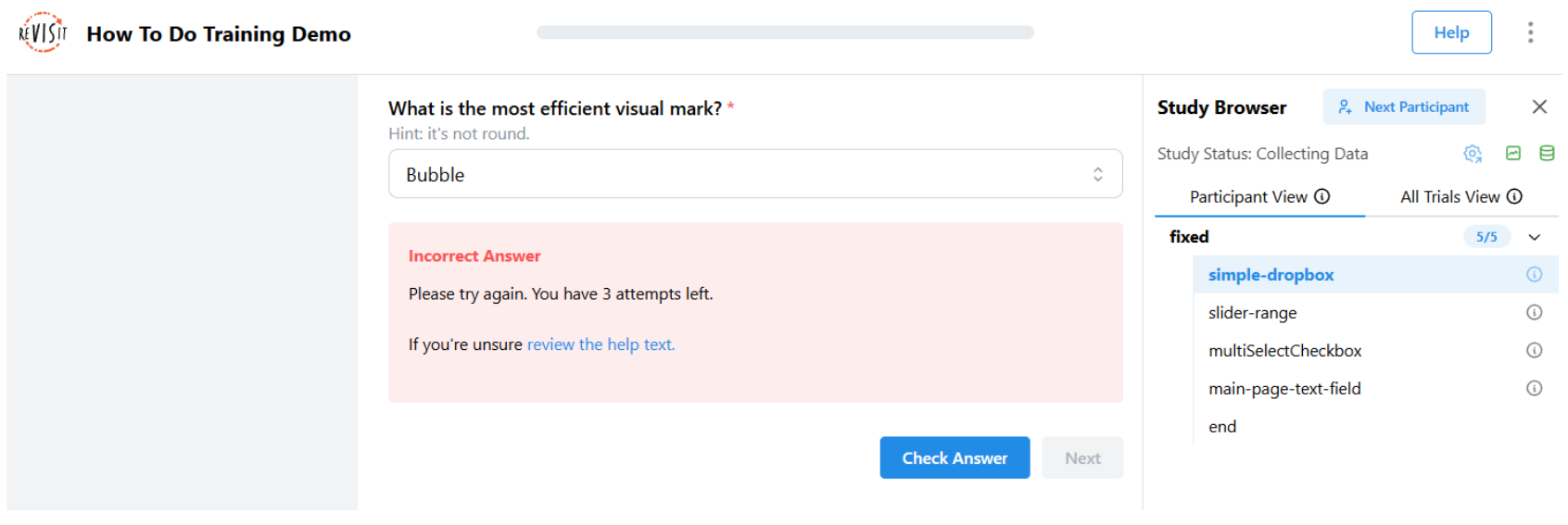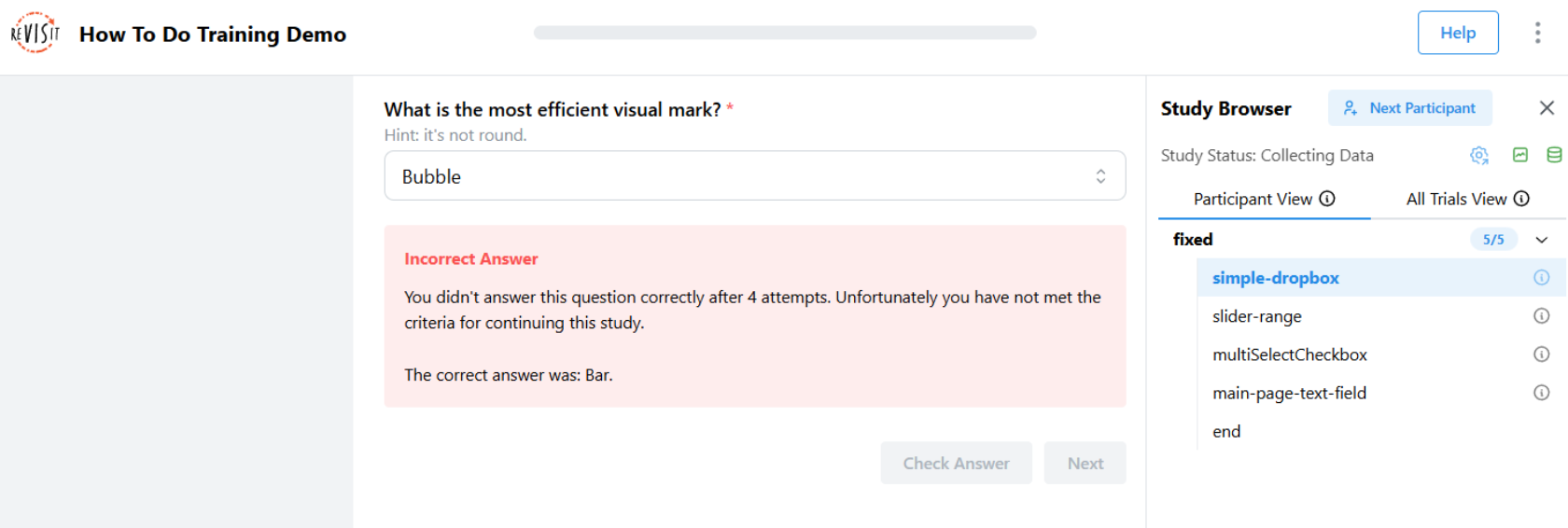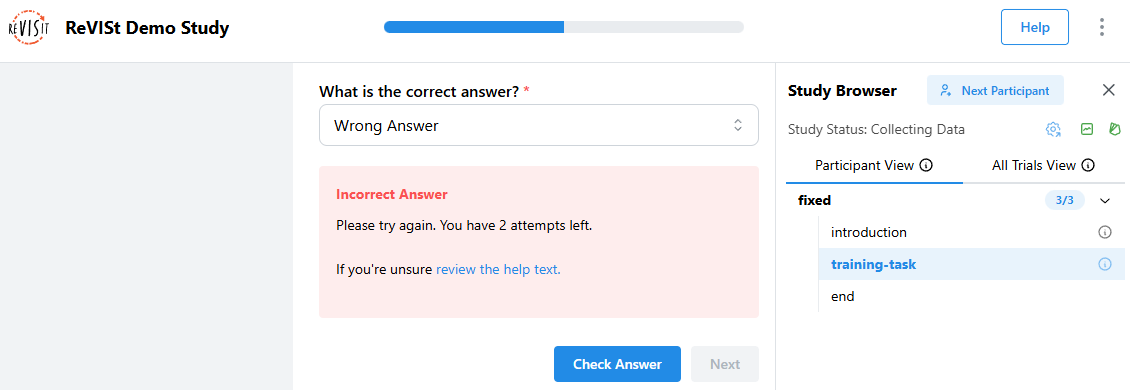Responses and Answers
In reVISit, a component typically has a response that is recorded when a participant completes a task. Responses can be provided via form elements or via some other kind of payload through your custom component and a ReactiveResponse.
Responses can optionally also be provided with an Answer that captures what the correct response is. This answer is used in several ways:
- If an answer is present, the data export will include data for the task that lists True and False for each response.
- In the analysis interface, tasks will be shown as correct or incorrect depending on the answer.
- Answers can be used to check the response during the experiment, which is useful for training.
There might be situations when answers cannot accurately capture whether a response was correct or not (e.g., with text input). In other situations, answers may have "degrees of correctness". In such cases, you will have to compute correct answers as part of your data analysis process.
Specifying Answers and Trainings
When you develop an online study, it's often important to train participants well before they can take a study. Typically, you want to give them an example task, but also provide help and hints at first. Here we lay out possibilities to develop trainings in reVISit leveraging responses and answers.
For a working example, refer to the demo and the associated config.
Here's a simple dropdown component asking what the most efficient visual mark is. The correctAnswer field contains an answer for the q-mark-type response that specifies that the correct answer is Bar.
"simple-dropbox": {
"type": "questionnaire",
"response": [
{
"id": "q-mark-type",
"type": "dropdown",
"required": true,
"prompt": "What is the most efficient visual mark?",
"secondaryText": "Hint: it's not round.",
"placeholder": "Choose mark",
"options": [
"Bar",
"Bubble",
"Pie",
"Stacked Bar"
]
}
],
"correctAnswer": [
{
"id": "q-mark-type",
"answer": "Bar"
}
],
"provideFeedback": true,
"allowFailedTraining": false,
"trainingAttempts": 4
}
The last three lines specify that this is used for training:
The provideFeedback field adds a "Check Answer" button to the UI, which can be used to validate the answer based on the provided correct answer.

The above screenshot shows an example for when the response was incorrect.
Optionally, you can specify that trainings have to be successfully completed with the allowFailedTraining flag. You can specify the number of attempts with the trainingAttempts field. When failing is not allowed and the participant exceeds the number of failed attempts, the study will terminate.

Navigation Buttons
You can customize the behavior and appearance of navigation buttons in your study components. These options can be set globally in the uiConfig or overridden on individual components.
Next
The next button offers several customization options. You can change the button text using nextButtonText (e.g., "Continue", "Next Question") and control its location with nextButtonLocation.
To enable keyboard navigation, set nextOnEnter to true, which allows participants to press Enter to move to the next question.
For timing control, you can use nextButtonEnableTime to delay when the button becomes clickable, which helps ensure participants have time to read the content, and nextButtonDisableTime to set a time limit after which the button becomes disabled, which is useful for time-limited tasks.
You can also combine nextButtonDisableTime with timeoutReject to automatically reject participants who do not click the next button within the time limit. This setup is useful for enforcing strict time constraints in tasks or training phases.

"uiConfig": {
...
"timeoutReject": true
},
"components": {
"timed-task": {
"type": "questionnaire",
"nextButtonText": "Continue",
"nextOnEnter": true,
"nextButtonEnableTime": 2000,
"nextButtonDisableTime": 30000,
"response": [
{
"id": "q1",
"prompt": "Answer within 30 seconds",
"type": "shortText"
}
]
}
}
Check Answer
When you set correctAnswer and provideFeedback to true, a "Check Answer" button appears next to the Next button. Participants can click this button to see if their answer is right or wrong before moving on.
The Check Answer button uses trainingAttempts to limit how many times participants can check their answer. When a participant gets the answer right, the Check Answer button turns off and the Next button turns on. If you set trainingAttempts to a number, the button turns off after that many tries.
You can choose what happens when participants fail training by setting allowFailedTraining. When set to false, participants who use up all their tries without getting the answer right will be rejected from the study.
"components": {
"training-task": {
"type": "questionnaire",
"provideFeedback": true,
"trainingAttempts": 3,
"allowFailedTraining": false,
"correctAnswer": [
{
"id": "q1",
"answer": "Correct Answer"
}
],
"response": [
{
"id": "q1",
"prompt": "What is the correct answer?",
"type": "dropdown",
"options": ["Correct Answer", "Wrong Answer", "Another Wrong Answer"]
}
]
}
}

Previous
You can enable the previous button by setting previousButton to true, which lets participants move back through earlier parts of the study if needed. You can also customize the button text with previousButtonText.
"components": {
"survey": {
"type": "questionnaire",
"previousButton": true,
"previousButtonText": "Back",
"response": [
{
"id": "q1",
"prompt": "First question?",
"type": "shortText"
},
{
"id": "q2",
"prompt": "Second question?",
"type": "dropdown",
"options": ["Option A", "Option B"]
}
]
}
}
